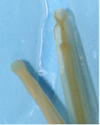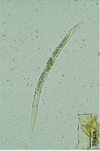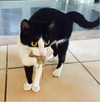Exam 1 Flashcards
(150 cards)
What 6 questions about parasites are Veterinarians asked by their clients?
- What is it?
- How can you tell my animal has it?
- Where did it come from? How did my animal become infected/infested?
- What harm does it cause?
- How can it be gotten rid of? How can it be prevented? Controlled?
- Will it infect people?
type of host that a parasite is (in/on) in which the parasite can develop
host spectrum
its called _____ when a host can develop completely in one host
host specific
its called ___ when a parasite can develop in several different hosts
broad host spectrum
True or false?
A parasite may require 1 or more hosts for development or may utilise a host (ex. insect) simply for transmission between hosts.
True
_______ is the term used when endoparasites, such as helminths and protozoa, infect the host internally
Infection
_______ is the term used when ectoparasites, such as acari and insects, attach to or occupy the host
Infestation
______ is the preferred site in or on the host, which is characteristic for a parasite species
Predilection site
______ is the site in or on a host which is not a normal location for a parasite.
Aberrant site
______ is is the mechanism of how a disease develops
Pathogenisis
Pathogenisis includes chronological changes that give rise to gross changes and clinical signs in which (3) host structures?
- cells
- organs
- tissues
________ are the differences found in tissues of an animal from what is normal, and are observed by eye or microscopically.
Lesions
Lesions seen with your eyes
gross lesions
Lesions seen with microsopy
microscopic lesions
these are somewhat similar to bacterial or viral infections; the host is infected, and in most cases, species, or strain-specific, immunity develops, the parasite is eliminated, and the host is protected against a subsequent infection,
self limiting infections
the infection may be long standing, sometimes for years
chronic infection
True or false?
The pathogenesis of a parasite does not directly relate to the importance of a parasite and the need (or not) to treat for the parasite
false
(does directly relate)
True or false?
The clinical signs associated with disease may be a result of both the parasite and the host response to it
True
Describe helminth diagnosis techniques
- presence of adults, developing stages, eggs, or larvae in feces, blood, or urine remains the most common
- Serology (ELISA)
Describe protozoa diagnostic techniques
examination of
- fecal samples
- blood
- skin
- muscle
- other tissues
Ectoparasite diagnostic techniques dependent on?
- the collection and identification of the parasite(s)
- stages concerned
PPP
Prepatent period
time from infection to when eggs, cysts, or larvae appear in body fluids of, or excretions from, the difinitive host
What type of parasite does this “spaghetti” remind you of?

Nematodes
What type of parasite is this?

Nematode































































































































